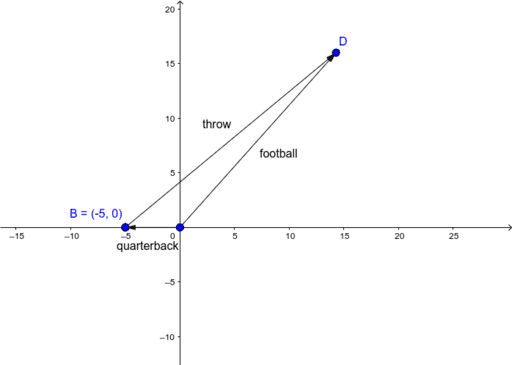Resultant Velocity Same Direction
How do you find velocity after 3 seconds. There are different directions you could draw that second arrow.

Relative Velocity Basic Introduction Youtube
For example if we have a force vecF of magnitude text25 textN acting in the positive y-direction we can draw it as a vector.

Resultant velocity same direction. 4 h 5 km h-1 east 20 km east In this case the velocity vector 5 km h-1 east is multiplied by 4 h scalar the resultant vector 20 km east is a displacement vector different nature directed towards the east same direction. 2 R 2 F 1 2 F 2 2 2 F 1 F 2 cos 9 0 0 5 0 F 1 2 F 2 2. Correct answer to the question How would you calculate the resultant velocity of two velocities in the same direction.
The resultant velocity of the system will be-. Suppose the two vectors are A and B NOW If they are parallel to each other their resultant will be the sum of those two vectors. You could draw it antiparallel so the sum is smaller.
Velocity is a vector because it has both speed and direction. Resultant velocity is the vector sum of all given individual velocities. That would be acceleration in the same direction as velocity and would result in the velocity increasing the object speeds up.
If playback doesnt begin shortly try restarting your device. When objects move through a fluid such as air or water the fluid exerts a frictional force on the moving object. You could draw it parallel to in the same direction as the first arrow.
Change minutes into seconds so that the final result would be in meters per. They are all parallel to the x-direction and parallel to each other. Average speed and average velocity can have different magnitudes.
Any vector quantities can be added together like this. If two or more velocity vectors are added then the result is a resultant velocity. The resultant velocity in this case is 294 meters per second.
The car is therefore accelerating towards the finish line. The direction of the resultant is the same as the original vector. When two same vectors act at different angle on a particle the value and direction of resultant vector can be determined easily by using formula.
Videos you watch may be added to the TVs watch history and influence TV recommendations. The resultant velocity of an object is the sum of its individual vector velocities. The sum of the vector forces on an object is equal to the scalar product of the objects mass and its acceleration vector.
In the diagram the vectors have the same magnitude because the arrows are the same length and they have the same direction. Two bodies of same mass are moving with same velocity V in mutually opposite directions. How do you find velocity with seconds.
For example if an object falls for 3 seconds multiply 3 by 98 meters per second squared which is the acceleration from gravity. For example- If the two vectors are A and B and they are parallel to each other then their resultant will. But any two vectors can be added as long as they are the same vector quantity.
How would you calculate the resultant velocity of two velocities in the same direction. Multiply the acceleration by the time the object is being accelerated. When displacement vectors are added the result is a resultant displacement.
Correct answer to the question. Friction- Key Ideas The force of friction opposes the motion of an object causing moving objects to lose energy and slow down. The resultant force is 1500 1000 500 N and it is acting in the same direction as the car is moving forwards.
The process of changing value of velocity can be determined easily. This applies equally in the y-direction. The displacement and average velocity vectors point in the same direction.
The frictional force from a fluid is. How and by which formula the direction of velocity will be determined if force acts with velocity at right angle. The resultant velocity in this case is 294 meters per second.
The resultant velocity is in the same direction of the larger velocity. After 3 seconds the velocity is 453159 ms. There are many ways to calculate vector sums such as using a vector addition diagram but using trigonometry to calculate vector components is.
Provided an object traveled 500 meters in 3 minutes to calculate the average velocity you should take the following steps. They collide and stick together. How do you calculate resultant velocity of two velocities in opposite directions.
That is acceleration opposite the velocity which makes you slow down. Resultant force when the forces are at right angle Ref. The above discussion pertains to the result of adding displacement vectors.
What helps to slow down a moving object.

Graphical Analytical Component Method Ppt Video Online Download

Resultant Velocity An Overview Sciencedirect Topics

Relative Motion Velocity In Two Dimensions Formulas Videos Examples

Addition Of Velocities Physics

Two Objects A And B Are Moving In Opposite Directions With Velocities Youtube

Relative And Resultant Velocity Aim How Do We Calculate The Resultant Velocity Of An Object Moving Relative To Other Moving Objects Do Now You Are Walking Ppt Download

Resultant Velocity An Overview Sciencedirect Topics

Calculating Relative Velocity Video Khan Academy

Vectors Fundamentals And Operations Ppt Video Online Download
Why Do We Break Vectors Into Components In Relative Motion Why Don T We Just Subtract Them Directly Quora
Physics Magnitude Of Resultant Vectors

Resultant Speed Direction Two Forces Geogebra

Resultant Velocity An Overview Sciencedirect Topics

Relative And Resultant Velocity Aim How Do We Calculate The Resultant Velocity Of An Object Moving Relative To Other Moving Objects Do Now You Are Walking Ppt Download




Comments
Post a Comment